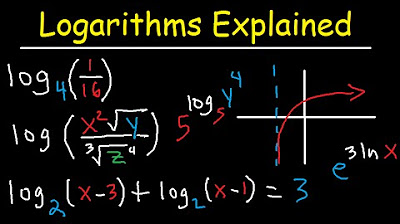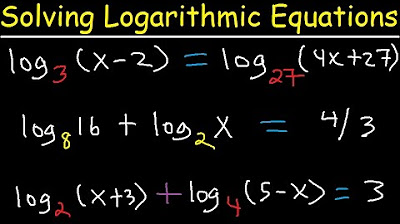Solving Logarithmic Equations
TLDRThis video lesson focuses on solving basic logarithmic equations, using various strategies such as converting log forms to exponential forms, applying the change of base formula, and using properties of logs. The instructor walks through numerous examples, demonstrating how to isolate and solve for the variable x in different logarithmic expressions, including complex equations involving multiple logs and natural logs. The lesson is designed to build a strong foundation in logarithmic functions and their applications.
Takeaways
- 📝 To solve logarithmic equations, convert them to their exponential form.
- 🔍 For log base b of a is equal to x, the exponential form is b to the power of x equals a, such as 2^x = 16 leading to x = 4.
- 🌟 Use the change of base formula, log base b of a divided by log base b of c equals log base b of a/c, to solve problems with different bases.
- 👉 When taking roots to solve equations, like finding the fourth root, use the property that a number to the fourth power is the root raised to the first power.
- 📌 In equations with multiple logarithms, use properties like log a plus log b equals log (a times b) to combine them into a single logarithm.
- 🔢 For equations like log base b (x plus c) equals d, convert to exponential form to find the value of x, as in 3^4 equals 81 minus c.
- 💡 In cases where the logarithm has no base specified, it defaults to base 10, such as 10^24 for log x equals 24.
- 🌐 Natural logarithms (ln) have base e, so eln(x) equals x, and can be used to solve equations like ln x equals 7 leading to x = e^7.
- 📊 Quadratic equations can arise from logarithmic expressions, solve them by factoring or using the quadratic formula.
- 🔍 When solving equations with logarithms, check for extraneous solutions that may result in negative numbers inside a log, which are not valid.
- 🔧 Use properties of logarithms to manipulate and solve equations, such as log a minus log b equals log (a divided by b).
Q & A
How do you convert a logarithmic equation to its exponential form?
-To convert a logarithmic equation to its exponential form, you rewrite the equation so that the variable is the exponent instead of the logarithm. For example, if you have log base b of x equals y, you would rewrite it as b to the power of y equals x.
What is the value of x in the equation log base 2 of 16 equals x?
-In the equation log base 2 of 16 equals x, x is equal to 4 because 2 raised to the power of 4 (2^4) equals 16.
How do you solve the logarithmic equation log base x of 81 equals 4?
-To solve the equation log base x of 81 equals 4, you first convert it to its exponential form, which is x to the power of 4 equals 81. Then, you take the fourth root of 81, which is 3, to find the value of x.
What is the change of base formula used for in logarithms?
-The change of base formula is used to change the base of a logarithm to another base. It allows you to evaluate logarithms when the base is not a common number, such as 10 or e.
What is the value of x in the equation log base 5 of x equals 3?
-In the equation log base 5 of x equals 3, x is equal to 5 raised to the power of 3 (5^3), which is 125.
How do you find the value of x in the equation log base 32 of x equals 4/5?
-To find the value of x in the equation log base 32 of x equals 4/5, you first convert it to the exponential form, 32 to the power of 4/5 equals x. Then, you find the fifth root of 32 and raise it to the fourth power to solve for x, which results in x being equal to 16.
What is the assumption made about the base of a logarithm when it is not specified?
-When the base of a logarithm is not specified, it is assumed to be base 10.
What is the value of x in the equation ln x equals 7?
-In the equation ln x equals 7, x is equal to e raised to the power of 7 (e^7), which is approximately 1096.65 in decimal form.
How do you solve the equation log base 3 of (5x + 2) equals log base 3 of (7x - 8)?
-Since the bases are the same in the equation log base 3 of (5x + 2) equals log base 3 of (7x - 8), the expressions inside the logs must be equal. Therefore, you can set 5x + 2 equal to 7x - 8 and solve for x to find that x equals 5.
What is the significance of the property log a plus log b equals log (a times b)?
-The property log a plus log b equals log (a times b) is significant because it allows you to combine multiple logarithms into a single logarithm when they share the same base. This simplifies the equation and makes it easier to solve.
How do you find the value of x in the equation log base 2 of (x squared + 4x) equals log base 2 of 5?
-In the equation log base 2 of (x squared + 4x) equals log base 2 of 5, since the bases are the same, the expressions inside the logs must be equal. Therefore, you can set x squared + 4x equal to 5 and solve the resulting quadratic equation to find that x equals -5 or x equals 1.
Outlines
📚 Solving Basic Logarithmic Equations
This paragraph introduces the process of solving basic logarithmic equations. It begins with an example of solving log base 2 of 16 equals x, converting the logarithmic form to its exponential form (2^x = 16), and finding that x equals 4. The explanation continues with additional examples, including using the change of base formula and solving for x in various logarithmic expressions. The paragraph emphasizes understanding the relationship between logarithms and exponents and applying that knowledge to solve equations.
🔢 Applying Logarithmic Properties and Techniques
This paragraph delves into applying logarithmic properties and techniques to solve more complex equations. It covers topics such as solving for x in equations with logarithms of different bases, using natural logarithms (ln), and handling logarithms with no explicit base (defaulting to base 10). The explanation includes solving equations with logarithms of quadratic expressions and applying properties like log(a) + log(b) = log(ab). This section reinforces the importance of understanding logarithmic rules to efficiently solve equations.
🧠 Challenging Logarithmic Equations with Multiple Logs
This paragraph presents more challenging logarithmic equations that involve multiple logs and different bases. It explains how to combine logs with the same base using properties such as log(a) - log(b) = log(a/b) and how to convert these into exponential forms for easier solving. The paragraph also addresses the concept of extraneous solutions and how to identify them when solving logarithmic equations. The focus is on understanding the intricacies of logarithmic equations and the methods to find the correct solutions.
📈 Exponential Forms and Logarithmic Equations
This paragraph focuses on converting exponential forms into logarithmic equations and vice versa. It explains how to manipulate equations involving logs and exponents to isolate the variable and solve for it. The section covers various examples, including equations with a single log, multiple logs, and logs with exponents. The emphasis is on understanding the relationship between logarithms and exponents and using this knowledge to transform and solve complex equations.
🤝 Logarithmic Equations with a Twist
This paragraph presents logarithmic equations with unique twists, such as equations involving the logarithm of a logarithm and equations with multiple logs that require factoring or special attention to avoid extraneous solutions. The explanation covers the process of solving these equations by converting them into exponential forms, factoring, and isolating the variable. The section highlights the importance of careful analysis and understanding of logarithmic properties to arrive at the correct solutions.
Mindmap
Keywords
💡logarithmic equations
💡exponential form
💡change of base formula
💡natural logs
💡quadratic equations
💡logarithmic properties
💡extraneous solutions
💡logarithmic functions
💡solving for x
💡domain of logarithms
💡logarithmic simplification
Highlights
Introduction to solving basic logarithmic equations.
Conversion of logarithmic equations to exponential form for easier solving.
Example of solving log base 2 of 16, demonstrating the process of finding the value of x.
Explanation of using the change of base formula to solve logarithmic equations.
Method for finding the value of x in an equation where log of x is given.
Process of converting logarithmic equations with fractional exponents to their exponential form.
Solution for logarithmic equations with no explicit base, assuming base 10.
Use of natural logarithgs (ln) and their base e in solving equations.
Strategy for solving logarithmic equations with quadratic expressions inside the log.
Explanation of how to solve logarithmic equations with addition and subtraction inside the log.
Process of finding the value of x in equations with multiple logs and a given number.
Use of properties of logs, such as log a plus log b equals log a times b, in solving equations.
Method for solving logarithmic equations with logs on both sides of the equation using division.
Explanation of how to handle negative numbers inside logarithms and checking for extraneous solutions.
Process of solving logarithmic equations with multiplication inside the log and addition/subtraction outside.
Strategy for solving equations with logs raised to the power of another log.
Solution for the equation involving the square of a logarithm, highlighting the importance of understanding the base.
Method for solving logarithmic equations with nested logs, such as log of log of x.
Transcripts
Browse More Related Video

Logarithms Explained Rules & Properties, Condense, Expand, Graphing & Solving Equations Introduction

Using Logarithms and Natural Logarithms in Chemistry

Deriving Natural Logarithms!

Solving Logarithmic Equations With Different Bases - Algebra 2 & Precalculus

Integral of Logarithmic Functions | Calculus

Introduction to Logarithmic Differentiation
5.0 / 5 (0 votes)
Thanks for rating: